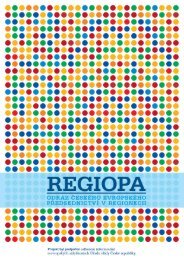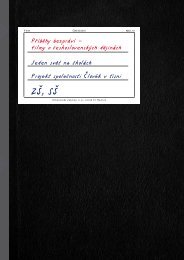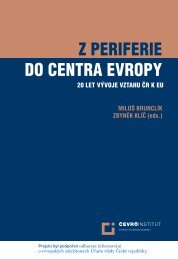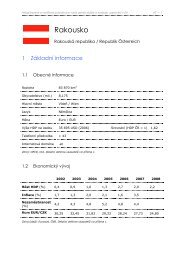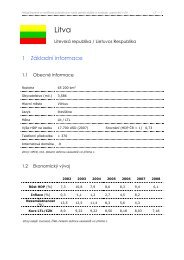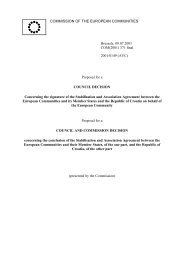CESTA KE SVOBODÄ PÅÃBÄHY BEZPRÃVÃ - Euroskop.cz
CESTA KE SVOBODÄ PÅÃBÄHY BEZPRÃVÃ - Euroskop.cz
CESTA KE SVOBODÄ PÅÃBÄHY BEZPRÃVÃ - Euroskop.cz
- No tags were found...
You also want an ePaper? Increase the reach of your titles
YUMPU automatically turns print PDFs into web optimized ePapers that Google loves.
they eventually caught them thanks to the carelessness of an accomplice who was on theperiphery of the organisation. The group’s leaders were arrested and sentenced to death.A large number of similar groups were also active in Czechoslovakia at the time (includingSvětlana and Hory Hostýnské (“Hostýn Hills”) to name but a few). Hundreds of peoplewere involved with these organisations.From today’s perspective, attacking secretariats, communist functionaries and policestations (not to mention minor sabotage operations) can seem like irrelevant, needlesslyprovocative and excessively violent actions. In the early days of the communist regimein Czechoslovakia, however, they were important and they could be justified. Thosewho took part in the operations wanted to frighten the Communist Party machine andvarious informers. They were determined to make it obvious that not everyone waswilling to be subjugated and to accept violence against their neighbours. They strived tocomplicate the Communist Party’s practical administrative measures as much as possible.For example, it is necessary to emphasise that the Mašín brothers believed there wouldbe a war between East and West, and that their actions were only meant to prepare theway for a “great conflict”.Groups linked with Western secret services,cross-border undercover agents and spiesThe activity of intelligence-gathering groups and armed organisations overlapped in places.Their members were motivated by similar things, such as a hatred of totalitarianism andtheir belief that it was necessary to support the democratic world, which would ultimatelydestroy the Soviet empire or at least liberate its colonies. One important espionageorganisation with links to the West revolved around the figure of Tomáš Oliva (whose realname was Jan Brejcha).As a young man, Brejcha had escaped from forced totalitarian labour in Germany and joinedthe RAF. He returned to the country after the War, but emigrated in 1949. He reappeared inCzechoslovakia in 1950 as a British secret service agent. According to StB documents, in themiddle of the year 1950, he recruited a large group of people in Prague and south Moravia.They gathered information for the British whilst also harbouring and supporting their agentsin Czechoslovakia. They operated and concealed transmitters, and helped couriers and refugeesget across the border. Brejcha’s accomplices included ordinary citizens. The StB managed tobreak up the group, but they were unable to apprehend all its members.Leopold Doležal is an example of the kind of person who took part in the espionage, and hisstory illustrates the sort of risks that people like him took. He was a senior officer in theNational Security Corps and was also a member of the Communist Party. In June 1950, Doležalmoved a transmitter from one hiding place to another with the help of his fellow police officerTomáš Hradský. He also hid the British agent Josef Kolísko in his home for 14 days and gavehim information on the StB before subsequently finding him a new place of refuge. He wasarrested in November 1950 but did his utmost to hold out for a long time under interrogationso as to enable the other members of the group who were still at large to escape abroad. Doležalwas subsequently sentenced to death and executed on 30 August 1952.Hundreds of people in Czechoslovakia collaborated with Western secret services at that time.One group who deserve a special mention are cross-border undercover agents (sometimescalled couriers) such as Ota Rambousek. He fled to the West after 1948 and became an agentof the American secret service (CIC). He returned to Czechoslovakia on foot and relayedinformation from local sources. He managed to cross the border 14 times altogether beforebeing arrested. He was sentenced to life in prison in 1950. People like the brothers Jiří andJosef Zenáhlík worked for the French. The communist secret police (StB), however, locatedJosef’s transmitter and both brothers were sentenced to life imprisonment in 1953.Cross-border undercover agents ran huge risks. The Czechoslovak security services guardedthe borders with ever-increasing professionalism and the agents could never be surewhether the people they relied upon for help and cooperation were being monitored by theStB or if they were informers.Fighting the regime as part of the struggle for religious freedomIt is not possible in this text to describe all the anti-communist resistance that took placein the years 1948–1955 (from the communist putsch up to the time when most opponentsof communism had been “pacified”). For example, right after February 1948, thecommunists refused to accept a number of clergy, particularly Roman Catholics (naturallythis also applied to members of the Catholic lay community). Many of these people foughtprimarily for their faith, but this also meant that they battled for the principle of freedomand therefore they were also attacking the very essence of the totalitarian state and itscommunist ideology.The Communist Party only formally recognised religious freedom. It viewed the CatholicChurch, which had several million adherents after the War, as its strongest “enemy on thehome front”. In its eyes, the Church was a compact, influential and ideologically powerfulcommunity, which was also naturally allied to the West. As early as June 1948, PresidentKlement Gottwald declared that it was necessary “to cut the Catholic Church off from theVatican… it is essential to neutralise the Church and to put it in our hands so that it serves the regime”.Consequently, the party soon began systematically destroying traditional religious lifeand the Church hierarchy. The Church was supposed to operate in accordance with statedirectives. Official propaganda relentlessly attacked the Vatican and the Church’s mostimportant representatives (who were interned or thrown into jail after several trials).They then gradually replaced these people with collaborators.From the outset, the Church defended itself in many ways. For example, in June 1949, Czechand Slovak bishops sanctioned an extensive pastoral letter entitled “Czechoslovak BishopsCall on the Faithful in a Time of Great Trial”. Among other things, this document enumeratedthe prerequisites necessary for preserving the freedom of the Church (the right of thefamily to raise and educate children, independent Christian teaching in schools and otherinstitutions, the right to congregate in free associations, the required number of Churchschools, etc.). The communists reacted to the pastoral letter by interning Archbishop JosefBeran and launching a number of repressive measures. Secret police went from parish toparish and confiscated the missive. Up to that time it had been distributed in secret. Priestswho read the document in church despite the risk ended up behind bars.36 | 37



